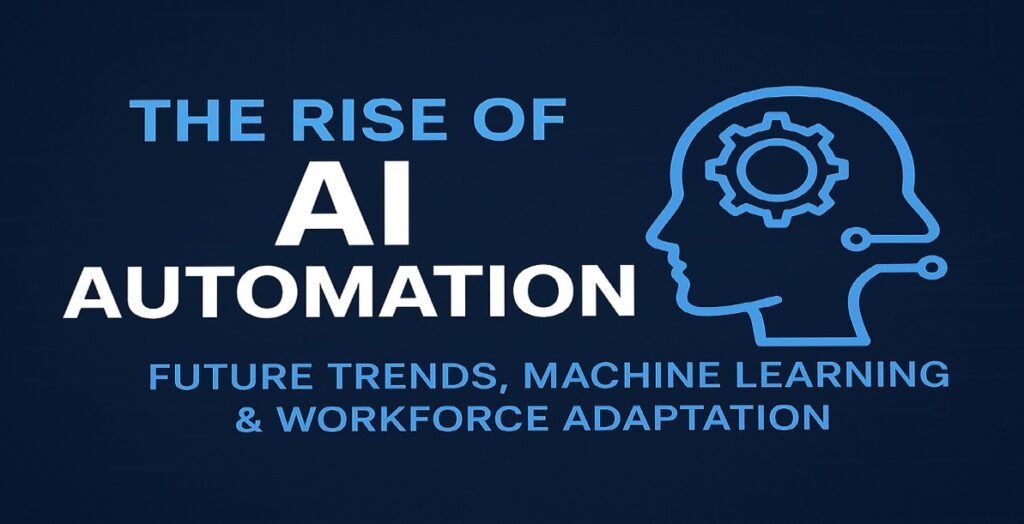AI Automation and the Future of Artificial Intelligence: Transforming Businesses and Workforces
In the rapidly evolving digital era, AI automation has shifted from being a futuristic concept to a practical reality that shapes our daily lives. From managing complex data to streamlining operations, artificial intelligence (AI) is no longer an optional tool—it has become an essential driver of growth and innovation. Businesses, governments, and individuals are now racing to understand how to harness its potential effectively.

Understanding AI Automation
At its core, AI automation refers to using artificial intelligence to perform tasks without direct human intervention. Unlike traditional automation that follows fixed rules, AI-driven automation can adapt, learn, and improve over time. This makes it far more powerful and versatile.
Consider customer service chatbots that not only answer basic questions but also learn from previous interactions to provide more accurate solutions. In manufacturing, AI-powered robots can detect production issues before they occur, reducing downtime and increasing efficiency. Even in healthcare, AI systems are analyzing medical scans faster and more accurately than human specialists.
By combining speed, precision, and adaptability, AI automation creates opportunities that were unimaginable just a decade ago.
The Future of Artificial Intelligence
The future of artificial intelligence holds both promise and challenges. On one hand, advancements in AI will enable machines to perform more complex cognitive tasks—tasks that once required human intuition and expertise. For instance, predictive algorithms could anticipate market shifts, personalized learning platforms might adjust in real time to a student’s pace, and autonomous vehicles could dramatically reduce traffic accidents.
However, the future will also require careful regulation and ethical oversight. Concerns about privacy, data security, and decision-making transparency are growing. As AI becomes more integrated into governance, healthcare, finance, and everyday consumer technology, ensuring fairness and accountability will be critical. The challenge will be to balance innovation with responsibility.
Machine Learning Integration: The Engine Behind AI’s Growth
While AI is the broader concept, machine learning integration is what powers many of its breakthroughs. Machine learning (ML) allows systems to improve automatically by learning from experience. This means the more data an AI system processes, the smarter it becomes.
In retail, integrating machine learning into analytics platforms enables businesses to forecast demand more accurately, manage inventory efficiently, and deliver personalized marketing campaigns. In agriculture, ML helps optimize irrigation, predict crop yields, and detect diseases early. These examples demonstrate that machine learning integration isn’t just a technical upgrade—it’s a strategic advantage.
Importantly, integration also means blending AI with existing systems in a way that enhances rather than disrupts current operations. This often involves retraining teams, adjusting workflows, and rethinking entire business models.
AI in Business Operations
When it comes to AI in business operations, the transformation is already well underway. Companies are using AI to optimize supply chains, detect fraud, automate administrative tasks, and enhance decision-making. These applications save both time and resources, allowing businesses to focus on strategic growth.
For example, AI-powered analytics can identify hidden patterns in customer behavior, enabling more targeted marketing and product development. In logistics, route optimization algorithms reduce fuel costs and delivery times. Even HR departments are leveraging AI to screen resumes, assess candidate fit, and improve employee retention strategies.
By integrating AI into daily operations, organizations gain a competitive edge in both efficiency and innovation.
Workforce Adaptation to AI
Perhaps one of the most pressing topics in this technological shift is workforce adaptation to AI. While automation can eliminate repetitive and low-value tasks, it also creates new opportunities for employees to focus on creativity, problem-solving, and strategic thinking.
Adapting the workforce involves more than just technical training—it requires a cultural shift. Companies must encourage lifelong learning, reskilling programs, and collaboration between human and machine capabilities. For example, data analysts may transition into roles as AI system trainers, guiding algorithms to make better decisions. Customer service representatives might oversee AI chatbots, stepping in only when complex or sensitive issues arise.
Governments and educational institutions will also play a role by updating curricula and providing resources to help people transition into AI-era careers.
Conclusion: A Balanced Path Forward
The convergence of AI automation, machine learning integration, and AI in business operations is accelerating global transformation. While the future of artificial intelligence offers unprecedented opportunities, it also demands thoughtful adaptation from the workforce. The most successful organizations will be those that not only adopt AI but also prepare their people to thrive alongside it.
In this evolving landscape, the goal is not to replace humans but to empower them—leveraging AI as a partner in innovation, efficiency, and problem-solving. By striking this balance, we can ensure that artificial intelligence becomes a force for progress, benefiting businesses, individuals, and society as a whole.